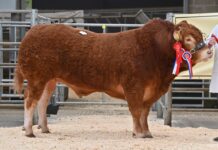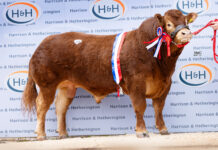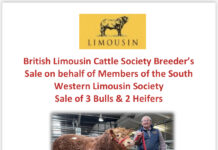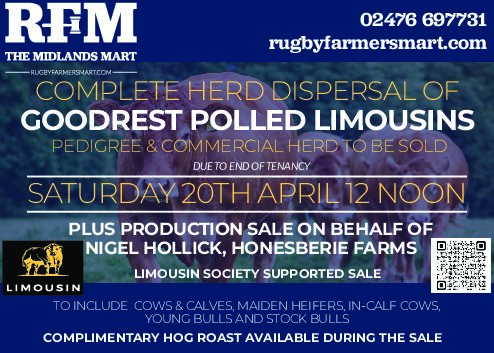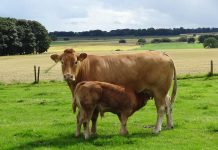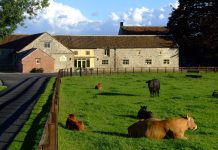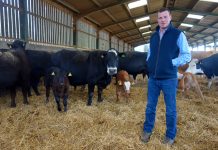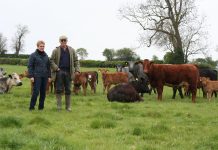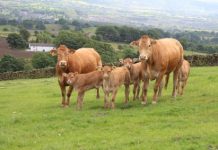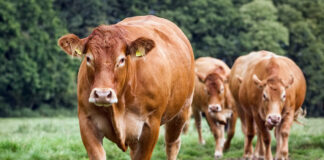Strattons Farms in Hampshire is a good example of how the Limousin can help to improve herd performance over a relatively short period of time.
When Simon Hill took on the role of Farm Manager in 2002, he inherited a diverse mix of cattle, including Limousin, Blonde d’Aquitaine and Charolais crosses. Working with dedicated stockman, Bill Ferguson, he immediately set about trying to upgrade the herd, by investing in a team of high quality Limousin stock bulls.
In 2008, the herd was selected out of a 13-strong entry as winner of the South East Commercial Herd Competition. Judges were Mike and Jean Dickens of Little Horwood, Buckinghamshire. Meanwhile, the farm’s home-bred Strattons VIP, a Fleethill Sabin son, won the best working bull in the medium herd (south-east) class. In the same year, the herd also came runner-up as best pedigree medium herd in the South East region.
The farm, which is owned by Sir Timothy and Lady Sainsbury, carries around 130 Limousin cross females, plus a small pedigree herd registered under the Strattons prefix. The 1,600 acre holding also grows a number of arable crops including wheat, barley, oats and oilseed rape.
Among the bulls that have been chosen for their ability to make a positive influence on the herd is Anside Ajax (LM+21). A son of Fleethill Talisman, he was purchased for 3,300gns at Carlisle in February 2006, aged 19 months. The bull was put forward by Stephen Irvine of Braehead Farm, Banffshire.
The 2005-born Lowgate Adonis (LM+31), by Greenwell Major and out of Lowgate Minnie, has also proved to be a good investment. He was worth every penny of his 3,000gns price tag, says Bill. The bull was bred by Ian Brown of Lincolnshire.
“We reckon to pay up to 6,000gns for a good stock bull,” says Bill. “But we have noticed that prices are creeping up. A bull that used to cost 4,000gns is now unlikely to go for anything less that 8,000-9,000gns.
“You can trace the breeding of Ajax and Adonis as far back as 25-30 years on both the sire and the dam’s side – that is very important,” he adds. “We felt we got a bargain when we bought Adonis, because there is not one bad animal in his pedigree.”
Not to be left out is Strattons VIP, the bull that won the best working bull medium herd (south-east) competition. He has sired a large number of high quality progeny, and is very easy calving.
Bill points out that the farm is in a predominantly arable area, and there is little chance of getting someone to come out to AI the cows within a tight timeframe. However he has not ruled out the possibility of attending an AI training course at some point in the future. Happily, Bill and Simon hold similar views when they head out to a sale.
“We like to see a big frame, and plenty of length. Bulls without good length won’t throw cattle that will grade well at the slaughter house,” says Bill. “With the cows, we also prefer a large animal, weighing about 800kgs.”
As Bill used to work for Michael Gray’s father, it comes as no surprise that cattle from the Fleethill herd at Llandrindod Wells have found favour. As well as featuring in the bull pedigrees at Strattons Farms, the Fleethill prefix is also attached to six females that were bought as heifers.
With finished cattle being the main commodity, attention is paid to EBVs, particularly the figures relating to growth rates. The cattle are sold deadweight to ABP, at liveweights of 600-700kgs. Grades never dip below R4L, and U- and U+ are commonplace, with pedigree bulls rejected for breeding generally achieving E grade. The farm receives a traditional beef premium for all finished cattle.
“We need to achieve high daily liveweight gain figures, and produce cattle that have good tops and rumps, as well as high killing out percentages,” he explains. “ABP gives us a lot of feedback, and we have learned that the top line on a carcase is by far the most important aspect of an animal’s conformation. That’s where the most expensive cuts are found.
“I would like to see pedigree breeders coming out to farms like ours, so that we can exchange information and make sure our meat reaches the specification demanded by our customers.” Very few heifers are finished at Strattons, because it is more profitable to sell them for breeding. Getting the females away at 12 months old also eases the pressure on winter housing. When it comes to calving, all efforts are focused on keeping a tight pattern, to avoid peak times within the arable enterprises and to help achieve even batches of calves. Some 70% of cows fall into the February to April group, with the rest calving from September to November. Bill ensures that bulls only run with each cow group for a maximum of 10-12 weeks.
“The quickest way to lose money on a suckler herd is keeping cows that do not get in calf,” observes Bill. “Our current herd is comparatively young, because we took advantage of the OCDS scheme before it ended.”
He is a firm believer in calving the cows inside. “If there is a problem overnight, I can attend to it easily. They really need round the clock attention during this period,” he says. “I try to avoid over-feeding, because I think it can lead to calving problems.”
The straw-bedded buildings at Strattons Farms are light and airy, and respiratory diseases are rare. Another way of improving the ventilation is the inclusion of a run-out area, which is a feature in all the newer buildings. Bill likes to clip the cattle’s backs for two reasons.
“Using a pour-on wormer on cattle that have thick coats wastes a lot of the product, and reduces its efficacy,” he says. “Clipping also helps to keep them cool. Another routine task is shortening their tails and making sure their hindquarters are kept clean, to keep the flies away.”
A total mixed ration system is used to feed most classes of livestock, with biscuit waste and sugar beet forming part of the cows’ diet. For growing cattle, the ration includes home-grown oats and barley, plus a specialist blend that is made to the farm’s own specifications. Creep feed containing rolled oats and a 16% protein cake is offered to the calves from six weeks onwards.
Starting this year, the farm is pursuing a policy of working towards Johne’s disease-free accreditation, with the support of the vet. Bill is also keen to maintain the herd’s four year TB testing status, and will not buy a bull without these credentials. “Good herd health is a very important factor in profitability. This is just one of the reasons why the female side operates as a virtually closed herd.
“Our policy on TB testing status limits our choice of bull, but we feel it is a sacrifice that’s worth making. Our wish is that more pedigree breeders would declare their health status.”
It is clear that teamwork plays a key role in the success of the beef cattle enterprise at Strattons Farms, with Bill’s excellent stockmanship and attention to detail and Simon’s tight control over the figures. Their joint aim of producing cattle with the sole intention of pleasing their customers is clearly paying off. It is a fitting tribute to the Limousin that it has been the breed of choice in fulfilling their aim.


